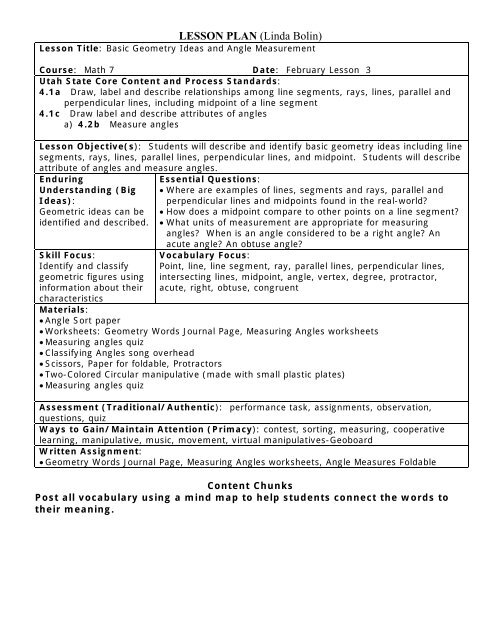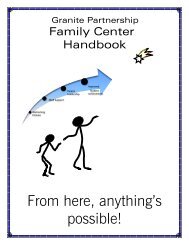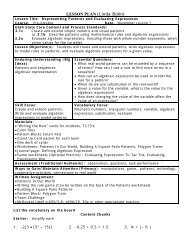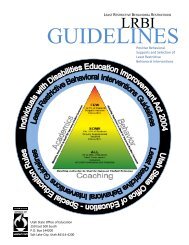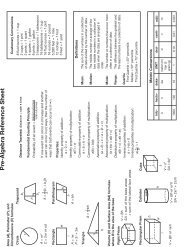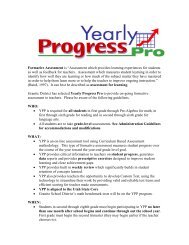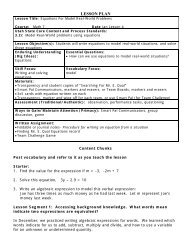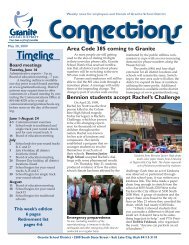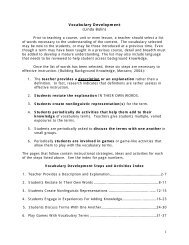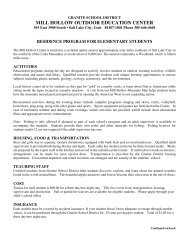LESSON PLAN (Linda Bolin) - Granite School District
LESSON PLAN (Linda Bolin) - Granite School District
LESSON PLAN (Linda Bolin) - Granite School District
Create successful ePaper yourself
Turn your PDF publications into a flip-book with our unique Google optimized e-Paper software.
<strong>LESSON</strong> <strong>PLAN</strong> (<strong>Linda</strong> <strong>Bolin</strong>)<br />
Lesson Title: Basic Geometry Ideas and Angle Measurement<br />
Course: Math 7 Date: February Lesson 3<br />
Utah State Core Content and Process Standards:<br />
4.1a Draw, label and describe relationships among line segments, rays, lines, parallel and<br />
perpendicular lines, including midpoint of a line segment<br />
4.1c Draw label and describe attributes of angles<br />
a) 4.2b Measure angles<br />
Lesson Objective(s): Students will describe and identify basic geometry ideas including line<br />
segments, rays, lines, parallel lines, perpendicular lines, and midpoint. Students will describe<br />
attribute of angles and measure angles.<br />
Enduring<br />
Understanding (Big<br />
Ideas):<br />
Geometric ideas can be<br />
identified and described.<br />
Skill Focus:<br />
Identify and classify<br />
geometric figures using<br />
information about their<br />
characteristics<br />
Essential Questions:<br />
• Where are examples of lines, segments and rays, parallel and<br />
perpendicular lines and midpoints found in the real-world?<br />
• How does a midpoint compare to other points on a line segment?<br />
• What units of measurement are appropriate for measuring<br />
angles? When is an angle considered to be a right angle? An<br />
acute angle? An obtuse angle?<br />
Vocabulary Focus:<br />
Point, line, line segment, ray, parallel lines, perpendicular lines,<br />
intersecting lines, midpoint, angle, vertex, degree, protractor,<br />
acute, right, obtuse, congruent<br />
Materials:<br />
• Angle Sort paper<br />
• Worksheets: Geometry Words Journal Page, Measuring Angles worksheets<br />
• Measuring angles quiz<br />
• Classifying Angles song overhead<br />
• Scissors, Paper for foldable, Protractors<br />
• Two-Colored Circular manipulative (made with small plastic plates)<br />
• Measuring angles quiz<br />
Assessment (Traditional/Authentic): performance task, assignments, observation,<br />
questions, quiz<br />
Ways to Gain/Maintain Attention (Primacy): contest, sorting, measuring, cooperative<br />
learning, manipulative, music, movement, virtual manipulatives-Geoboard<br />
Written Assignment:<br />
• Geometry Words Journal Page, Measuring Angles worksheets, Angle Measures Foldable<br />
Content Chunks<br />
Post all vocabulary using a mind map to help students connect the words to<br />
their meaning.
Starter: How great is your memory from your past experiences<br />
Contest? Try to match each word to the correct picture.<br />
1. Point a. •<br />
2. Line segment b. • •<br />
3. Line c.<br />
4. Ray d. •<br />
5. Parallel lines e.<br />
6. Perpendicular lines f.<br />
7. Angle g.<br />
8. Midpoint h. ●<br />
Lesson Segment 1: Where are examples of lines, segments and rays, parallel<br />
and perpendicular lines and midpoints found in the real-world? found in the<br />
real-world? How does midpoint differ from other points on a line?<br />
This can be a contest where small groups compete to see how many they can name. As<br />
you discuss the starter with the students, have them begin to fill in the Geometry<br />
Words journal page (attached). Assign each team of students one idea from the starter<br />
except “angle” to consider three real-world examples or situations. Select one person<br />
from each team to share the examples, so the class can choose one of those to write<br />
on their journal page. As you discuss the ideas, have students fill in their own words<br />
and sketches.<br />
Lesson Segment 2: Where are examples of angles found or used in the realworld?<br />
Guessing game: Tell students you are thinking of one of the geometric ideas and<br />
that you will point to some examples of that idea in the room. When they think they<br />
might know what the idea you are thinking of is, they may write the idea down. After<br />
pointing to several examples that suggest where an angle might be formed, ask for<br />
responses. Ask students to describe attributes for some of the angles you pointed to<br />
such as where the vertex point might be, or where the line segments are which form<br />
the angle. Show the math symbol for angle.
Lesson Segment 3: How can I describe attributes of angles?<br />
Without giving information have students sort angles by cutting out the cards on<br />
the Angle Sort paper. Partners cut and sort, writing the rule for their sort. Then have<br />
the partners compare their sorting to another pair. Discuss with class the sort<br />
bringing them to the idea that angles can be described by the wideness or openness of<br />
the angle. This wideness is the measure of an angle. Remind them that they may<br />
have heard words such as acute, right or obtuse when describing angles.<br />
Sing this song with the students:<br />
Classifying Angles Song<br />
(to the tune of Skip To My Lou. Lyrics by <strong>Linda</strong> <strong>Bolin</strong>)<br />
Use arms to show each as the verse is sung.<br />
I’m a little angle. I like me like that.<br />
An ACUTE little angle, and I’m not fat.<br />
I’m an alligators mouth or a witches hat.<br />
I’m ACUTE. I’m less than 90.<br />
I’m a RIGHT angle, and I look square.<br />
Look for a corner, and I’ll be there.<br />
I’m a flag or a present. I’m everywhere.<br />
I’m just RIGHT. I’m exactly 90.<br />
I’m rather large, so I have pride.<br />
I’m an OBTUSE angle. I’m big inside.<br />
I’m a reclining chair or a door open wide.<br />
I’m OBTUSE. I am more than 90.<br />
Have students use Two-color Circular manipulative to show attributes such as acute,<br />
obtuse and right as you ask them to. (A two-color manipulative can easily be made to<br />
allow the students to demonstrate angles. Make a cut in two different colored small<br />
plastic plates from the circumference to the center of the plate. Slide the two plates<br />
together at the cut.)
Have students re-sort the angles into acute, right and obtuse categories (if they did not<br />
originally do so) and write the category on the back of the card.<br />
Lesson Segment 4: What is the measure for a given angle?<br />
Use the “Measuring Angles” investigation worksheet and protractors to become more<br />
familiar with the protractor and to measure angles.<br />
Practice:<br />
Make a three column foldable (as shown below). The back side of the foldable can be<br />
labeled “Measuring and Classifying Angles”. Have students use their protractors to<br />
measure each of the angles from the sort cards. Then have them use the protractor to<br />
sketch the angles in the appropriate column on the Foldable and label the measure of<br />
each angle.<br />
Acute
Geometry Words 1<br />
Word or<br />
phrase<br />
Symbol ( )<br />
Point ( )<br />
Line ( )<br />
Line segment<br />
( )<br />
Ray ( )<br />
Midpoint ( )<br />
Name:__________________<br />
Sketch A real-world example Definition<br />
(in your words)<br />
Parallel lines<br />
( )<br />
Perpendicular<br />
lines ( )<br />
Vertex ( )<br />
Degree<br />
Angle ( )<br />
Acute<br />
Right<br />
Obtuse<br />
Vertical<br />
Adjacent<br />
Complementary<br />
Supplementary
Classifying Angles Song<br />
(to the of Skip To My Lou. Lyrics by <strong>Linda</strong> <strong>Bolin</strong>)<br />
Use arms to show each as the verse is sung.<br />
I’m a little angle. I like me like that.<br />
An ACUTE little angle, and I’m not fat.<br />
I’m an alligators mouth or a witches hat.<br />
I’m ACUTE. I’m less than 90.<br />
I’m a RIGHT angle, and I look square.<br />
Look for a corner, and I’ll be there.<br />
I’m a flag or a present. I’m everywhere.<br />
I’m just RIGHT. I’m exactly 90.<br />
I’m rather large, so I have pride.<br />
I’m an OBTUSE angle. I’m big inside.<br />
I’m a reclining chair or a door open wide.<br />
I’m OBTUSE. I am more than 90.
Angle Sorting:<br />
Cut the angle cards apart. Sort them into three categories and write the rule<br />
for each category. Your categories can’t refer to angle positions such as upside-down,<br />
left or right.<br />
1<br />
2<br />
3<br />
4 5 6<br />
7<br />
8 9<br />
10 11 12
Measuring Angles<br />
Name_____________________<br />
C<br />
A<br />
B<br />
0˚<br />
1) What is an angle? Use the circle drawing to help you understand and explain.<br />
2) How can angles in circle A be the same size as angles in circle B and C when they<br />
look wider?<br />
3) When you turn around in a complete circle, you have traveled 360 degrees.<br />
Degrees are used to label the distance of a turn. Use a colored pencil to trace the<br />
line and label the degrees to show where each of the following turns would stop.<br />
Begin at 0˚ each time. Each line represents a turn of 15 degrees. The degrees are<br />
the measure of the angle.<br />
A. A 15˚ turn<br />
B. A 30˚ turn<br />
C. A 45˚ turn<br />
D. A 90˚ turn<br />
E. A 120˚ turn<br />
F. A 180˚ turn<br />
G. A 210˚ turn<br />
H. A 270˚ turn<br />
I. A 315˚ turn<br />
J. A 360˚ turn
C<br />
A<br />
B<br />
4) Look at a protractor. How is a protractor similar to the circle above? How is it<br />
different?<br />
5) Find the mark on your protractor that would represent the center of the circle.<br />
Where is that mark? This is the vertex point mark.<br />
6) Find the mark on your protractor that would represent 0˚. Where is the 0˚ mark?<br />
7) Find the mark on your protractor that would represent 180˚. Where is the 180˚<br />
mark?<br />
8) Each angle sketched below represents a turn. Place your protractor so the center<br />
mark is on the vertex of an angle. Line one of the segments up pointing to the 0˚<br />
mark. Now find the mark where the other line segment is pointing. How many<br />
degrees is the angle?
Name __________________<br />
Measuring Angles Quiz<br />
1. Label 0° and 180° on this protractor.<br />
2. Label “vertex” where the protractor will be placed on the angle vertex point.<br />
3. Sketch and label where a ray forming a 120° angle might pass through.<br />
4. Sketch a 45° angle in the space below the protractor.<br />
5. Where in this room would you see:<br />
An acute angle?<br />
A right angle?<br />
An obtuse angle?


